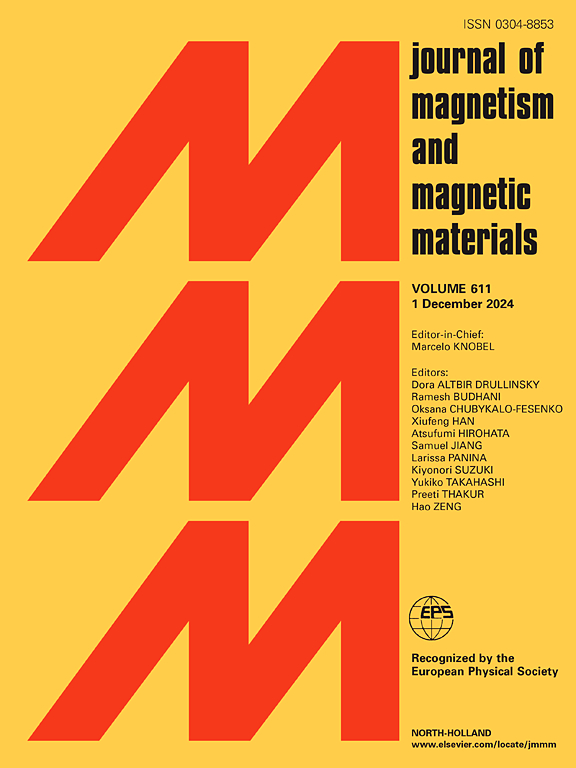Compositional optimization of rare earth permanent magnetic alloy by machine learning
IF 2.5
3区 材料科学
Q3 MATERIALS SCIENCE, MULTIDISCIPLINARY
引用次数: 0
Abstract
Machine learning (ML) is becoming increasingly crucial in the process of discovering and designing new materials. In this paper, we use the quaternary permanent magnetic alloy R(Co1-x-yFexMy)5 (0 ≤ x ≤ 0.08, 0.08 ≤ y ≤ 0.16) as an example to show how ML can be used in rare earth materials research. Our density functional theory (DFT) high-throughput screening, guided by the Korringa-Kohn-Rostoker coherent potential approximation (KKR-CPA) method, ranks the synthesis difficulty of M−site substituted components as follows, from least to most challenging: Hf, Zr, Cu, Zn/Ni, Ti, Si, and Cr. The magnetic-property data is then used to train and test active ML models, supplemented by Markov chain Monte Carlo (MCMC) iterations. Our model forecasts that substituting rare earth sites with Gd and Eu, and the Co site with Cr or Ni, can result in magnetic moments on par with or exceeding SmCo5. We further employ our model to optimize compositions and predict cost-effective, supply-reliable alternatives to SmCo5, particularly for those with lower Sm and Co content. ML is thus beneficial for compositional optimization, especially when the underlying structure–property relationships are not fully understood.
基于机器学习的稀土永磁合金成分优化
机器学习(ML)在发现和设计新材料的过程中变得越来越重要。本文以四元永磁合金R(Co1-x-yFexMy)5(0≤x≤0.08,0.08≤y≤0.16)为例,说明ML在稀土材料研究中的应用。在Korringa-Kohn-Rostoker相干电位近似(KKR-CPA)方法的指导下,我们的密度泛函数理论(DFT)高通量筛选,将M -位取代成分的合成难度按从最小到最具挑战性的顺序排列如下:Hf, Zr, Cu, Zn/Ni, Ti, Si和Cr。然后,磁性数据用于训练和测试主动ML模型,辅以马尔可夫链蒙特卡罗(MCMC)迭代。我们的模型预测,用Gd和Eu取代稀土位点,用Cr或Ni取代Co位点,可以产生与SmCo5相当或超过SmCo5的磁矩。我们进一步利用我们的模型来优化组合物,并预测具有成本效益,供应可靠的SmCo5替代品,特别是那些具有较低Sm和Co含量的替代品。因此,ML有利于组合优化,特别是当底层结构-属性关系没有完全理解时。
本文章由计算机程序翻译,如有差异,请以英文原文为准。
求助全文
约1分钟内获得全文
求助全文
来源期刊

Journal of Magnetism and Magnetic Materials
物理-材料科学:综合
CiteScore
5.30
自引率
11.10%
发文量
1149
审稿时长
59 days
期刊介绍:
The Journal of Magnetism and Magnetic Materials provides an important forum for the disclosure and discussion of original contributions covering the whole spectrum of topics, from basic magnetism to the technology and applications of magnetic materials. The journal encourages greater interaction between the basic and applied sub-disciplines of magnetism with comprehensive review articles, in addition to full-length contributions. In addition, other categories of contributions are welcome, including Critical Focused issues, Current Perspectives and Outreach to the General Public.
Main Categories:
Full-length articles:
Technically original research documents that report results of value to the communities that comprise the journal audience. The link between chemical, structural and microstructural properties on the one hand and magnetic properties on the other hand are encouraged.
In addition to general topics covering all areas of magnetism and magnetic materials, the full-length articles also include three sub-sections, focusing on Nanomagnetism, Spintronics and Applications.
The sub-section on Nanomagnetism contains articles on magnetic nanoparticles, nanowires, thin films, 2D materials and other nanoscale magnetic materials and their applications.
The sub-section on Spintronics contains articles on magnetoresistance, magnetoimpedance, magneto-optical phenomena, Micro-Electro-Mechanical Systems (MEMS), and other topics related to spin current control and magneto-transport phenomena. The sub-section on Applications display papers that focus on applications of magnetic materials. The applications need to show a connection to magnetism.
Review articles:
Review articles organize, clarify, and summarize existing major works in the areas covered by the Journal and provide comprehensive citations to the full spectrum of relevant literature.
 求助内容:
求助内容: 应助结果提醒方式:
应助结果提醒方式:


